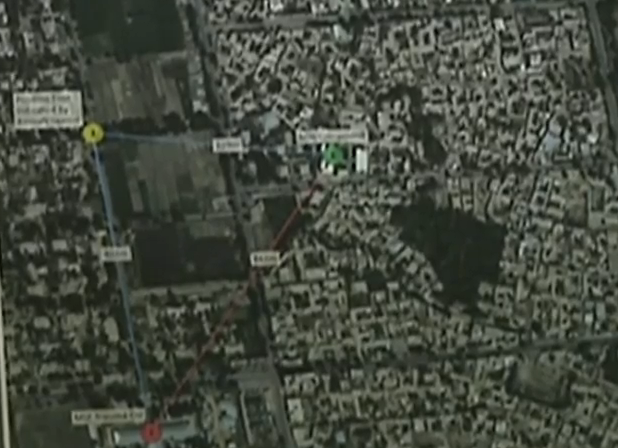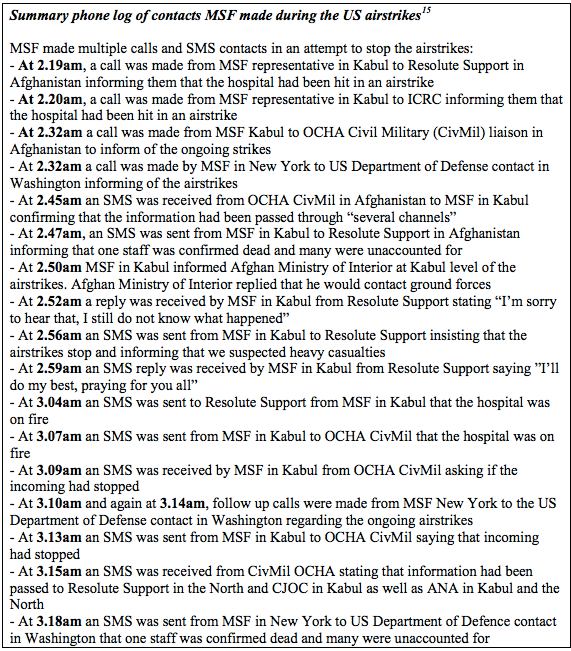WASHINGTON -- A Pentagon investigation into the October bombing of a Doctors Without Borders hospital in Kunduz, Afghanistan, found the airstrikes to be the result of “human error.”
The Pentagon has resisted calls for an independent investigation by an outside group into the Oct. 3 airstrikes that killed 30 Doctors Without Borders staff members and patients. On Wednesday, the military announced the conclusion of its own review of the incident.
“The report determined that the strike on the trauma center in Kunduz city, Afghanistan, was the direct result of human error compounded by systems and procedural failures,” Gen. John F. Campbell, the commander of U.S. forces in Afghanistan, said during a press briefing at the Pentagon.
The U.S. soldiers who executed the airstrikes did not know they were striking a hospital, Campbell said. Instead, they believed they were targeting a different building that is actually hundreds of meters away. But the military’s investigation found that both the personnel who called in the airstrikes and those who dropped the bombs “did not undertake the appropriate measures to verify that the facility was a legitimate target.”
Campbell said the soldiers directly involved in the airstrikes are currently suspended. Doctors Without Borders has said it believes the incident to be war crime.

During a 30-minute briefing, Campbell gave a play-by-play of the events leading up to what he called a “tragic but avoidable accident caused primarily by human error.”
U.S. special operations forces were deployed to the Kunduz airfield the morning of Sept. 29 and engaged in nearly five consecutive days and nights of heavy fighting against the Taliban, which had recently taken control of the city. Campbell acknowledged receiving coordinates of the Kunduz hospital from Doctors Without Borders on Sept. 29.
On the evening of Oct. 3, Afghan forces requested U.S. assistance from the air to clear out a building they suspected was occupied by Taliban insurgents.
The AC-130 aircraft that ultimately targeted the Doctors Without Borders hospital took off more than an hour early in response to an emergency "troops in contact" situation. Because of the early takeoff, the plane's crew didn't have the list of no-strike buildings, which included the hospital.
Once in flight, some of the plane’s electronic systems failed, preventing the crew from transmitting video footage and sending and receiving emails. After believing it was targeted by a missile, the crew flew 8 miles outside of its regular orbit, which interfered with the aircraft’s GPS censors.
When the crew entered the GPS coordinates for the building believed to be occupied by the Taliban, the coordinates identified an empty field 300 meters away. Crew members then visually located the nearest large building, which was the Doctors Without Borders hospital.
Before striking the hospital, the aircraft got back on its intended path and the GPS coordinates of its target realigned with the correct building. However, the crew did not reassess its target using the coordinates and instead "remained fixated on the physical description of the facility," according to the Department of Defense's findings.
Although the original misidentification resulted in part from technical malfunctions on the plane, Campbell conceded that there were signs the crew was zeroing in on the wrong target. In addition to the crew relying primarily on what what it had visually identified as the target, the members did not see any conflict from the air.

One minute before bombing the hospital, the crew aboard the AC-130 sent headquarters personnel at the Bagram Airfield the GPS coordinates of the building it visually identified as the correct target. The personnel at Bagram then failed to realize the coordinates matched the Doctors Without Borders hospital, which was on its list of protected, no-strike sites.
U.S. soldiers began firing on the hospital at 2:08 a.m. Just over 10 minutes later, Doctors Without Borders called the U.S. military and said its hospital was under attack. It took until 2:37 a.m. for the military to realize its mistake, Campbell said, adding that the firing had stopped by that time.
But a call log released by Doctors Without Borders, also known as Médecins Sans Frontières or MSF, shows that the organization called the U.S. military in Kabul at 2:56 a.m. “insisting that the airstrikes stop.” The group says it was under fire for nearly an hour.

“Our deepest condolences go to all the individuals and families who were affected by this tragic incident,” said Campbell, who praised the work of Doctors Without Borders and pledged to help rebuild the destroyed hospital. The U.S. military has also indicated it will provide condolence payments to the victims' families.
Although Campbell emphasized that the individuals conducting the military’s review were outside of his chain of command, its findings are unlikely to satisfy Doctors Without Borders, which has called for an investigation by an outside group with no connection to the U.S.
Pentagon spokesman Brig. Gen. Wilson Shoffner declined to answer directly when asked if the Pentagon would allow an outside investigation. He instead defended the military's findings. "We believe the investigation completed was full and impartial," he said.
But Doctors Without Borders said the military's review left it with more questions than answers.
"It is shocking that an attack can be carried out when U.S. forces have neither eyes on a target nor access to a no-strike list, and have malfunctioning communications systems," Christopher Stokes, the group's general director, said in a statement.
"It appears that 30 people were killed and hundreds of thousands of people are denied life-saving care in Kunduz simply because the MSF hospital was the closest large building to an open field and 'roughly matched' a description of an intended target," he continued.
Stokes criticized the military for chalking the October incident up to a breach of U.S. rules of engagement. "The frightening catalogue of errors outlined today illustrates gross negligence on the part of U.S. forces and violations of the rules of war," he said.
This article has been updated throughout.
